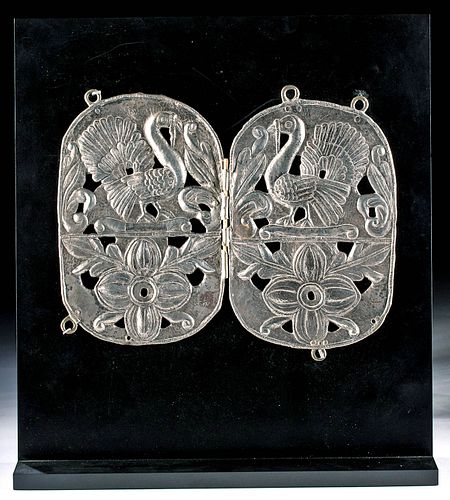18th C. Mexican Spanish Colonial Silver Bible Binding
Lot 124b
About Seller
Artemis Gallery
686 S Taylor Ave, Ste 106
Louisville, CO 80027
United States
Selling antiquities, ancient and ethnographic art online since 1993, Artemis Gallery specializes in Classical Antiquities (Egyptian, Greek, Roman, Near Eastern), Asian, Pre-Columbian, African / Tribal / Oceanographic art. Our extensive inventory includes pottery, stone, metal, wood, glass and textil...Read more
Categories
Estimate:
$2,000 - $3,000
Absentee vs Live bid
Two ways to bid:
- Leave a max absentee bid and the platform will bid on your behalf up to your maximum bid during the live auction.
- Bid live during the auction and your bids will be submitted real-time to the auctioneer.
Bid Increments
| Price | Bid Increment |
|---|---|
| $0 | $25 |
| $300 | $50 |
| $1,000 | $100 |
| $2,000 | $250 |
| $5,000 | $500 |
| $10,000 | $1,000 |
| $20,000 | $2,500 |
| $50,000 | $5,000 |
| $100,000 | $10,000 |
| $200,000 | $20,000 |
About Auction
By Artemis Gallery
Oct 22, 2020
Set Reminder
2020-10-22 10:00:00
2020-10-22 10:00:00
America/New_York
Bidsquare
Bidsquare : Ancient & Ethnographic Art Through The Ages
https://www.bidsquare.com/auctions/artemis-gallery/ancient-ethnographic-art-through-the-ages-5850
Ancient art from Egypt, Greece, Italy and the Near East, as well as Asian, Fossils, Pre-Columbian, Native American, African / Tribal / Oceanic, Fine art, and much more! All categories, all price ranges... all legally acquired and guaranteed to be as described or your money back. Artemis Gallery info@artemisgallery.com
Ancient art from Egypt, Greece, Italy and the Near East, as well as Asian, Fossils, Pre-Columbian, Native American, African / Tribal / Oceanic, Fine art, and much more! All categories, all price ranges... all legally acquired and guaranteed to be as described or your money back. Artemis Gallery info@artemisgallery.com
- Lot Description
North America, Mexico, Spanish Colonial Period, ca. 18th century CE. A pair of beautifully rendered repousse and openwork 92% silver panels designed to grace the front and back covers of a Bible, each featuring a motif of a turkey above a stylized rendering of the Golden Rose, a symbol of the Papacy. Fine details and floral motifs give each panel a lush appearance. The turkeys are a charming Mexican touch, celebrating the native bird and its striking plumage. Loops on the sides, a hinge between them, and a few small perforations for rivets show how these panels were once attached to the cover of a book. Silver-bound religious texts allowed people in the far flung corners of the vast Spanish Empire to maintain cultural ties with their deeply Catholic homeland - see another example from the Metropolitan Museum of Art (2018.220). Size: 9.5" W x 7.8" H (24.1 cm x 19.8 cm); 12.8" H (32.5 cm) on included custom stand; silver is 92%.
Silver decorative items like these panels attest to the mineral wealth of the Spanish New World colonies. Indeed, from ca. 1575 to 1635 CE, the Spanish colonial city of Potosi (now in Bolivia), produced roughly half of the world's silver! Even after Potosi's production declined following a dramatic currency fixing scandal in the 1640s, elite Spanish colonists continued to use silver for devotional purposes and to display and flaunt their wealth. Woman wore silver heeled shoes, church statues had silver crowns and halos, and all types of items - books, furniture, etc. - gained silver panels like this to decorate them. These give us a wonderful idea the things an upper class Spanish colonial home would have contained.
Provenance: ex-private Hawaii, USA collection, 2002
All items legal to buy/sell under U.S. Statute covering cultural patrimony Code 2600, CHAPTER 14, and are guaranteed to be as described or your money back.
A Certificate of Authenticity will accompany all winning bids.
We ship worldwide and handle all shipping in-house for your convenience.
#150958The original hinge pin is lost. Very slight bending to form, but otherwise they are in beautiful condition with light patina. They have not been examined off of their stand, where they are held in place by metal hooks.Condition
- Shipping Info
-
All shipping is handled in-house for your convenience. Your invoice from Artemis Gallery will include shipping calculation instructions. If in doubt, please inquire BEFORE bidding for estimated shipping costs for individual items.
-
- Buyer's Premium



 EUR
EUR CAD
CAD AUD
AUD GBP
GBP MXN
MXN HKD
HKD CNY
CNY MYR
MYR SEK
SEK SGD
SGD CHF
CHF THB
THB














